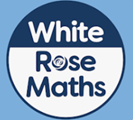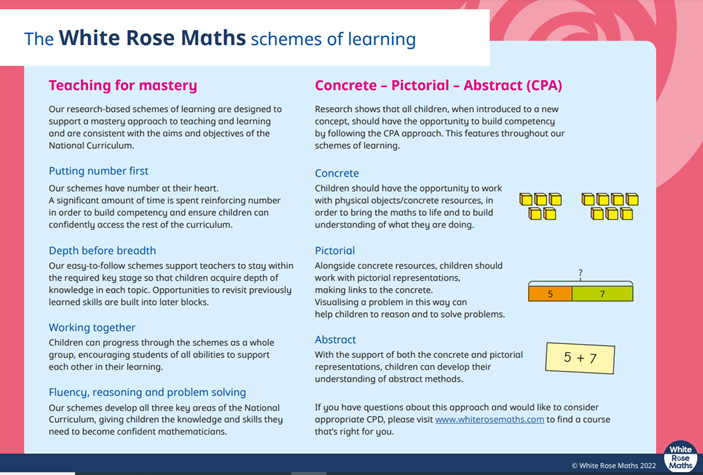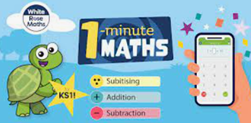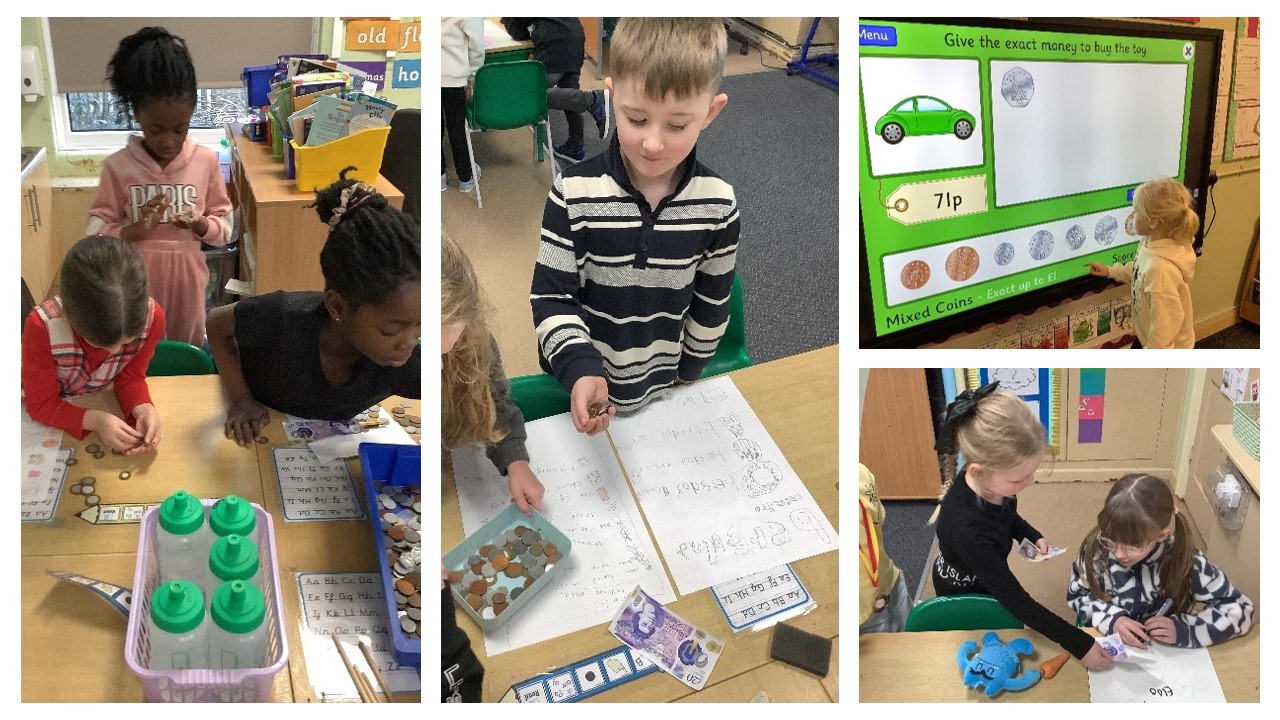Garlinge Primary School and Nursery, Westfield Road, Margate, Kent, CT9 5PA

Garlinge Primary School and Nursery, Westfield Road, Margate, Kent, CT9 5PA
The following information has been taken directly from the New National Curriculum and is now being implemented in our school.
Please click on the following links to see the yearly maths overview for each year group:
Mathematics is a creative and highly inter-connected discipline that has been developed over centuries, providing the solution to some of history's most intriguing problems. It is essential to everyday life, critical to science, technology and engineering, and necessary for financial literacy and most forms of employment. A high-quality mathematics education therefore provides a foundation for understanding the world, the ability to reason mathematically, an appreciation of the beauty and power of mathematics, and a sense of enjoyment and curiosity about the subject.
The National Curriculum for mathematics aims to ensure that all pupils:
Mathematics is an interconnected subject in which pupils need to be able to move fluently between representations of mathematical ideas. The programmes of study are, by necessity, organised into apparently distinct domains, but pupils should make rich connections across mathematical ideas to develop fluency, mathematical reasoning and competence in solving increasingly sophisticated problems. They should also apply their mathematical knowledge to science and other subjects.
The expectation is that the majority of pupils will move through the programmes of study at broadly the same pace. However, decisions about when to progress should always be based on the security of pupils' understanding and their readiness to progress to the next stage. Pupils who grasp concepts rapidly should be challenged through being offered rich and sophisticated problems before any acceleration through new content. Those who are not sufficiently fluent with earlier material should consolidate their understanding, including through additional practice, before moving on.

At Garlinge Primary School and Nursery, we follow the White Rose Maths scheme of learning, designed to support children’s learning by teaching for mastery using concrete, pictorial and abstract approaches. Their schemes develop all three key areas of the National Curriculum, giving children the knowledge and skills, they need to become confident mathematicians.

Have you heard about the White Rose Maths 1-minute maths app?
This is a great resource which is free to download. Challenge your children to complete a variety of tasks including addition, subtraction, multiplication and division. You can keep track of their scores with the downloadable wall chart and even print certificates to reward their progress. Each challenge takes 1 minute and helps children to build their number confidence and fluency.

Calculators should not be used as a substitute for good written and mental arithmetic. They should therefore only be introduced near the end of key stage 2 to support pupils' conceptual understanding and exploration of more complex number problems, if written and mental arithmetic are secure. In both primary and secondary schools, teachers should use their judgement about when ICT tools should be used.
The National Curriculum for mathematics reflects the importance of spoken language in pupils' development across the whole curriculum - cognitively, socially and linguistically. The quality and variety of language that pupils hear and speak are key factors in developing their mathematical vocabulary and presenting a mathematical justification, argument or proof. They must be assisted in making their thinking clear to themselves as well as others and teachers should ensure that pupils build secure foundations by using discussion to probe and remedy their misconceptions.
By the end of each key stage, pupils are expected to know, apply and understand the matters, skills and processes specified in the relevant programme of study.
Taken directly from the EYFS Statutory Framework:
I. Every child deserves the best possible start in life and the support that enables them to fulfil their potential. Children develop quickly in the early years and a child's experiences between birth and age five have a major impact on their future life chances. A secure, safe and happy childhood is important in its own right. Good parenting and high quality early learning together provide the foundation children need to make the most of their abilities and talents as they grow up.
II. The Early Years Foundation Stage (EYFS) sets the standards that all early years providers must meet to ensure that children learn and develop well and are kept healthy and safe. It promotes teaching and learning to ensure children's 'school readiness' and gives children the broad range of knowledge and skills that provide the right foundation for good future progress through school and life.
III. The EYFS seeks to provide:
IV. The EYFS specifies requirements for learning and development and for safeguarding children and promoting their welfare. The learning and development requirements cover:
V. The safeguarding and welfare requirements cover the steps that providers must take to keep children safe and promote their welfare.
VI. Four guiding principles should shape practice in early year's settings. These are:
Children count reliably with numbers from one to 20, place them in order and say which number is one more or one less than a given number. Using quantities and objects, they add and subtract two single-digit numbers and count on or back to find the answer. They solve problems, including doubling, halving and sharing.
Children use everyday language to talk about size, weight, capacity, position, distance, time and money to compare quantities and objects and to solve problems. They recognise, create and describe patterns. They explore characteristics of everyday objects and shapes and use mathematical language to describe them.
Years 1 and 2
The principal focus of mathematics teaching in key stage 1 is to ensure that pupils develop confidence and mental fluency with whole numbers, counting and place value. This should involve working with numerals, words and the four operations, including with practical resources [for example, concrete objects and measuring tools].
At this stage, pupils should develop their ability to recognise, describe, draw, compare and sort different shapes and use the related vocabulary. Teaching should also involve using a range of measures to describe and compare different quantities such as length, mass, capacity/volume, time and money.
By the end of year 2, pupils should know the number bonds to 20 and be precise in using and understanding place value. An emphasis on practice at this early stage will aid fluency. Pupils should read and spell mathematical vocabulary, at a level consistent with their increasing word reading and spelling knowledge at key stage 1.
Years 3 and 4
The principal focus of mathematics teaching in lower key stage 2 is to ensure that pupils become increasingly fluent with whole numbers and the four operations, including number facts and the concept of place value. This should ensure that pupils develop efficient written and mental methods and perform calculations accurately with increasingly large whole numbers.
At this stage, pupils should develop their ability to solve a range of problems, including with simple fractions and decimal place value. Teaching should also ensure that pupils draw with increasing accuracy and develop mathematical reasoning so they can analyse shapes and their properties, and confidently describe the relationships between them. It should ensure that they can use measuring instruments with accuracy and make connections between measure and number.
By the end of year 4, pupils should have memorised their multiplication tables up to and including the 12 multiplication table and show precision and fluency in their work. Pupils should read and spell mathematical vocabulary correctly and confidently, using their growing word reading knowledge and their knowledge of spelling.
Years 5 and 6
The principal focus of mathematics teaching in upper key stage 2 is to ensure that pupils extend their understanding of the number system and place value to include larger integers. This should develop the connections that pupils make between multiplication and division with fractions, decimals, percentages and ratio.
At this stage, pupils should develop their ability to solve a wider range of problems, including increasingly complex properties of numbers and arithmetic, and problems demanding efficient written and mental methods of calculation. With this foundation in arithmetic, pupils are introduced to the language of algebra as a means for solving a variety of problems. Teaching in geometry and measures should consolidate and extend knowledge developed in number. Teaching should also ensure that pupils classify shapes with increasingly complex geometric properties and that they learn the vocabulary they need to describe them.
By the end of year 6, pupils should be fluent in written methods for all four operations, including long multiplication and division, and in working with fractions, decimals and percentages.
We kindly ask you to support your child with learning their times tables at home. Practising this on a daily basis will help your child to recall and also use the inverse operation confidently.
Number bonds are also very important - to 10, 100, 1000 or 1.0 depending which year group your child is in.
At Garlinge Primary School and Nursery, we encourage the use of the Times Tables Rock Stars and Numbots websites to support our children with times tables learning and number knowledge. When you click on the login page, simply select ‘Garlinge Primary School and Nursery’ and then add your child’s username and password. Please speak to your child’s class teacher if you need a reminder of these or click on the forgotten password link to automatically alert the class teacher.
Click on the links below to visit the websites and to view the guidance on how best to support your children when using them.
http://www.conkermaths.org/http://www.ictgames.co.uk/http://www.woodlands-junior.kent.sch.ukhttp://www.mathszone.co.uk/http://www.bbc.co.uk/bitesize/ks2/maths/
Garlinge Primary School proudly took part in NSPCC Number Day, celebrating maths in a fun and engaging way. Children arrived dressed in creative outfits featuring numbers, shapes, and patterns, showcasing their enthusiasm for the subject. Throughout the day, pupils took part in a variety of hands-on maths activities, helping them develop problem-solving skills while having fun.
As part of the celebrations, some Year 2 children from Garlinge, Bromstone, and St Mildred’s came together to collaborate on maths challenges, working in teams to solve problems and answer questions. It was a fantastic opportunity for children to build confidence in maths, work together, and share ideas with their peers.
The event was a huge success, enjoyed by both children and staff. We are thrilled to announce that the school raised £121.74 for the NSPCC charity, supporting their vital work in keeping children safe.
A huge thank you to all parents, carers, and staff who contributed and helped make the day so special. Your generosity and support are greatly appreciated!
